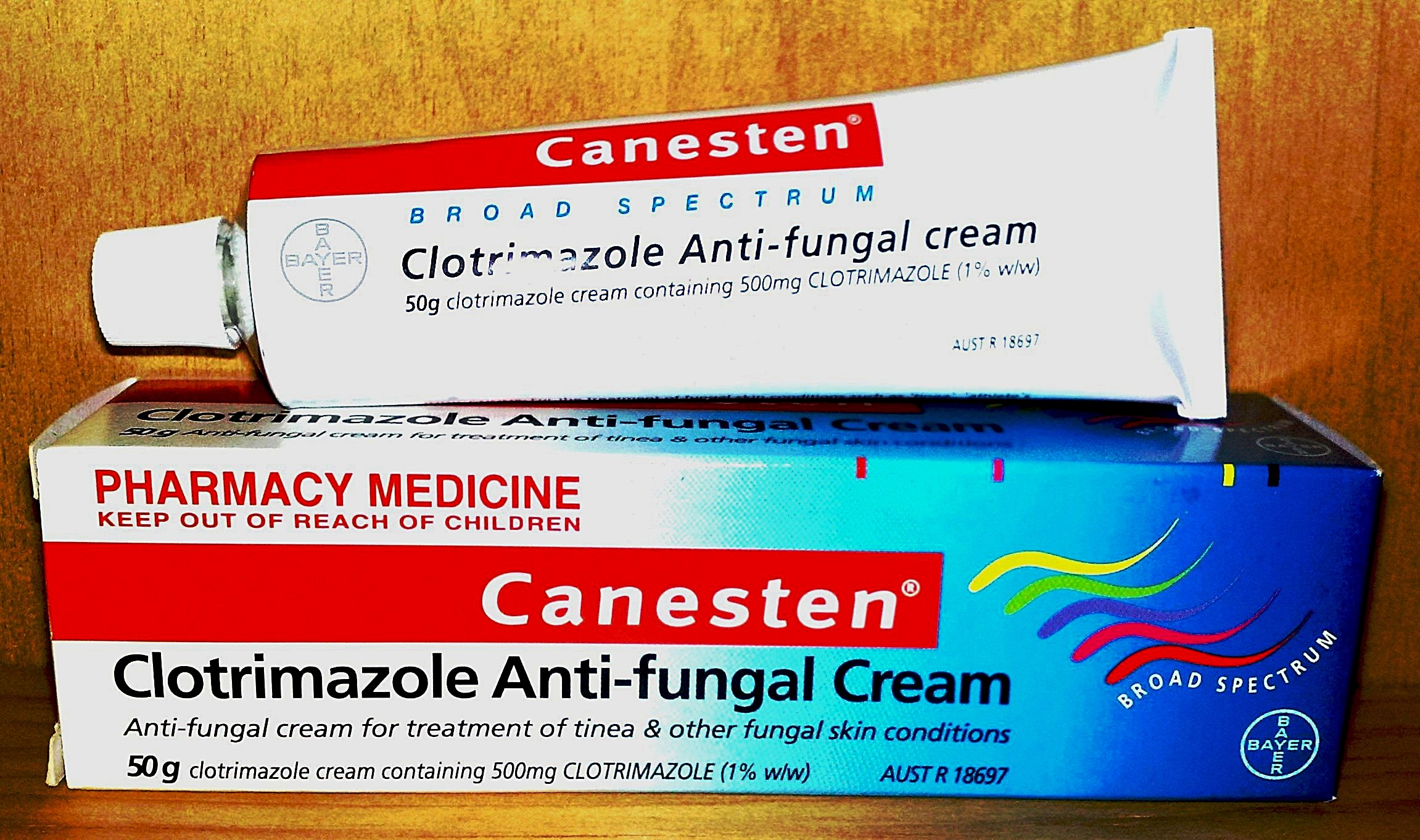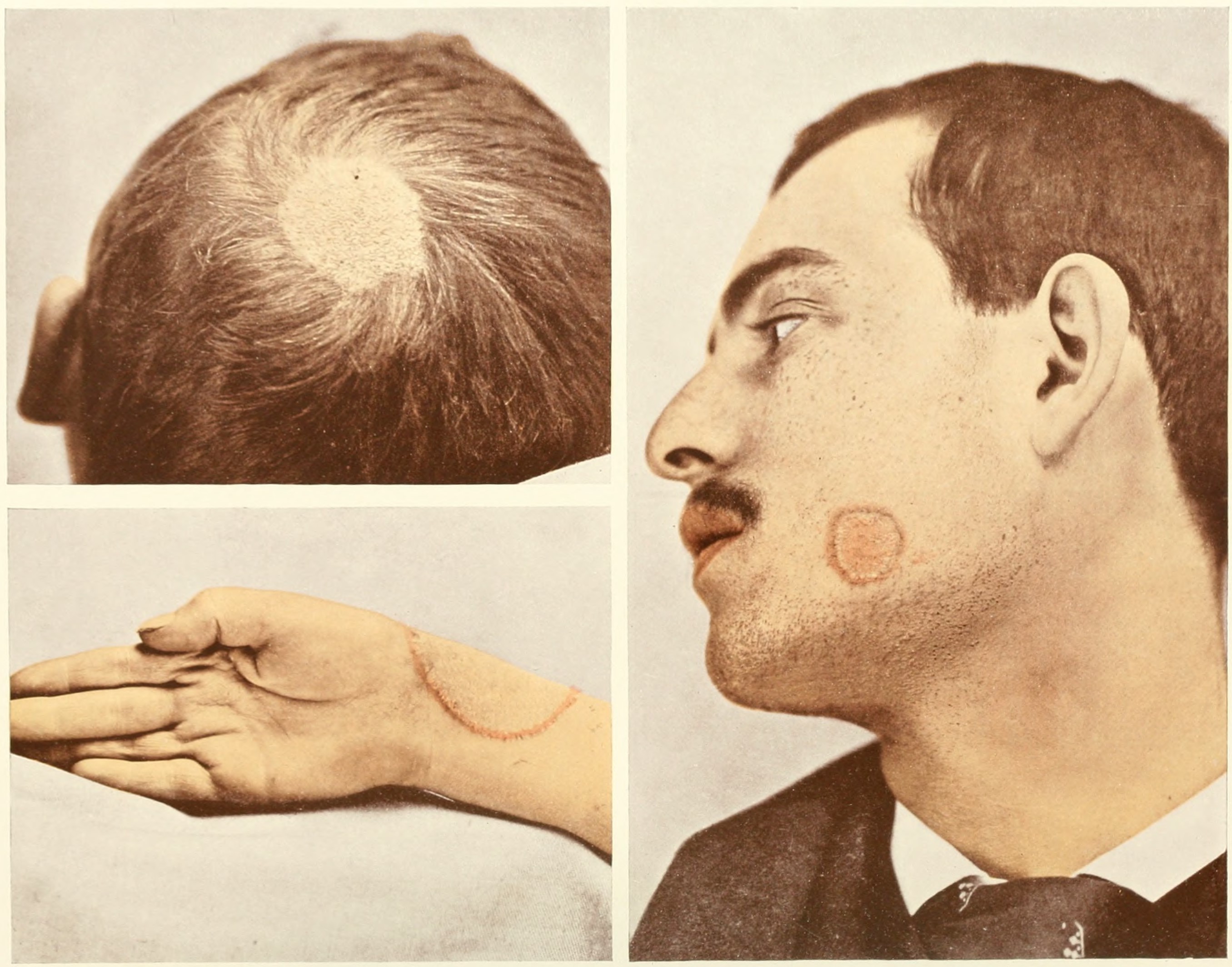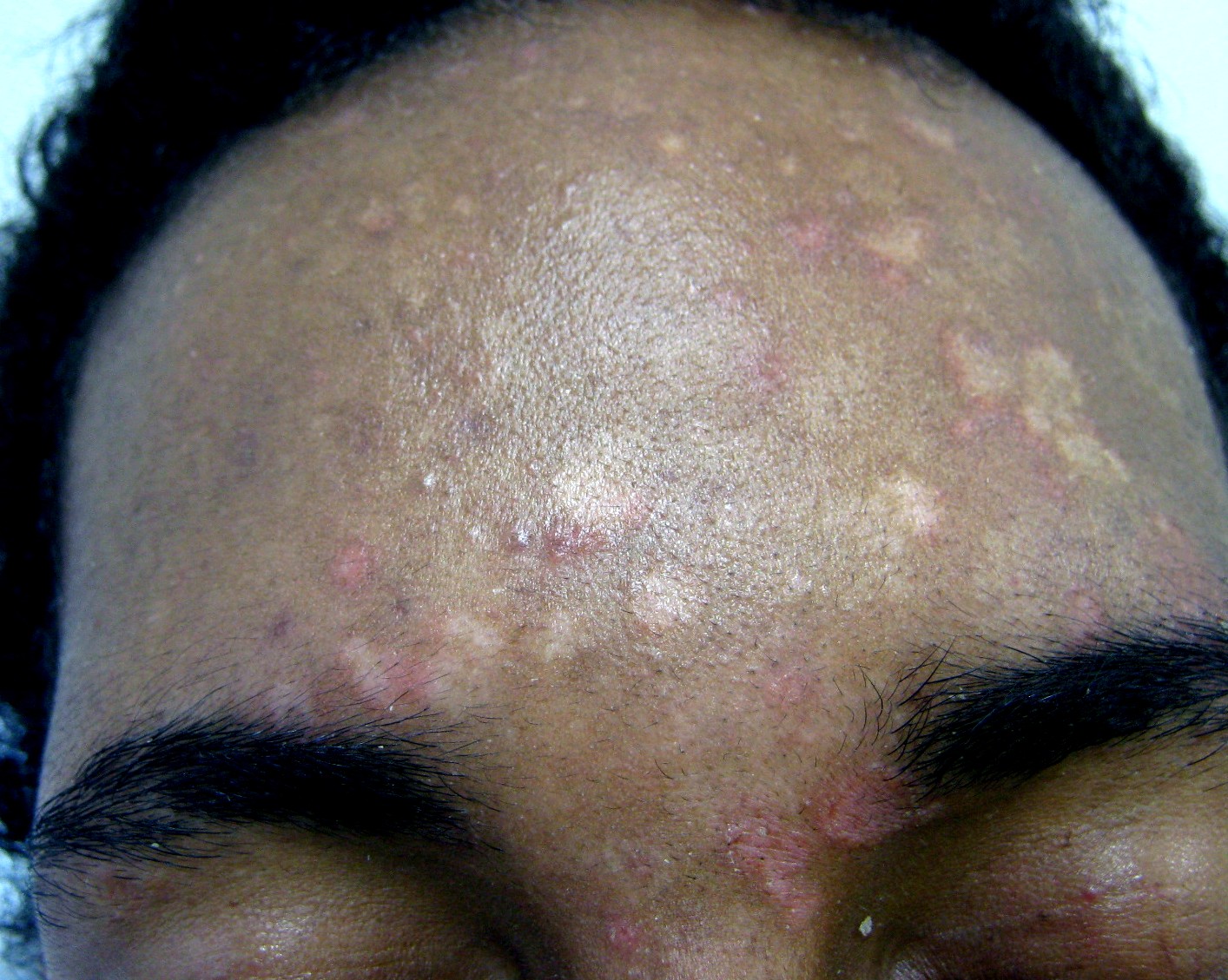|
Clotrimazole
Clotrimazole, sold under the brand name Lotrimin, among others, is an antifungal medication. It is used to treat vaginal yeast infections, oral thrush, diaper rash, tinea versicolor, and types of ringworm including athlete's foot and jock itch. It can be taken by mouth or applied as a cream to the skin or in the vagina. Common side effects when taken by mouth include nausea and itchiness. When applied to the skin, common side effects include redness and a burning sensation. In pregnancy, use on the skin or in the vagina is believed to be safe. There is no evidence of harm when used by mouth during pregnancy but this has been less well studied. When used by mouth, greater care should be taken in those with liver problems. It is in the azole class of medications and works by disrupting the fungal cell membrane. Clotrimazole was discovered in 1969. It is on the WHO Model List of Essential Medicines, World Health Organization's List of Essential Medicines. It is available as a ... [...More Info...] [...Related Items...] OR: [Wikipedia] [Google] [Baidu] |
Ringworm
Dermatophytosis, also known as tinea and ringworm, is a mycosis, fungal infection of the skin (a dermatomycosis), that may affect skin, hair, and nails. Typically it results in a red, itchy, scaly, circular rash. Hair loss may occur in the area affected. Symptoms begin four to fourteen days after exposure. The #Types, types of dermatophytosis are typically named for area of the body that they affect. Multiple areas can be affected at a given time. About 40 types of fungus can cause dermatophytosis. They are typically of the ''Trichophyton'', ''Microsporum'', or ''Epidermophyton'' type. Risk factors include using public showers, contact sports such as wrestling, excessive sweating, contact with animals, obesity, and immunosuppression, poor immune function. Ringworm can spread from other animals or between people. Diagnosis is often based on the appearance and symptoms. It may be confirmed by either microbial culture, culturing or looking at a skin scraping under a microscope. ... [...More Info...] [...Related Items...] OR: [Wikipedia] [Google] [Baidu] |
Yeast Infection
Candidiasis is a fungal infection due to any species of the genus '' Candida'' (a yeast). When it affects the mouth, in some countries it is commonly called thrush. Signs and symptoms include white patches on the tongue or other areas of the mouth and throat. Other symptoms may include soreness and problems swallowing. When it affects the vagina, it may be referred to as a yeast infection or thrush. Signs and symptoms include genital itching, burning, and sometimes a white "cottage cheese-like" discharge from the vagina. Yeast infections of the penis are less common and typically present with an itchy rash. Very rarely, yeast infections may become invasive, spreading to other parts of the body. This may result in fevers, among other symptoms. Finally, candiasis of the esophagus is an important risk factor for contracting esophageal cancer in individuals with achalasia. More than 20 types of ''Candida'' may cause infection with '' Candida albicans'' being the most common. Inf ... [...More Info...] [...Related Items...] OR: [Wikipedia] [Google] [Baidu] |
Vulvovaginal Candidiasis
Vaginal yeast infection, also known as candidal vulvovaginitis and vaginal thrush, is excessive growth of yeast in the vagina that results in irritation. The most common symptom is vaginal itching, which may be severe. Other symptoms include burning with urination, a thick, white vaginal discharge that typically does not smell bad, pain during sex, and redness around the vagina. Symptoms often worsen just before a period. Vaginal yeast infections are due to excessive growth of ''Candida''. These yeast are normally present in the vagina in small numbers. Vaginal yeast infections are typically caused by the yeast species ''Candida albicans''. ''Candida albicans'' is a common fungus often harbored in the mouth, digestive tract, or vagina without causing adverse symptoms. The causes of excessive ''Candida'' growth are not well understood, but some predisposing factors have been identified. It is not classified as a sexually transmitted infection; however, it may occur more often in ... [...More Info...] [...Related Items...] OR: [Wikipedia] [Google] [Baidu] |
Athlete's Foot
Athlete's foot, known medically as ''tinea pedis'', is a common skin infection of the feet caused by a fungus. Signs and symptoms often include itching, scaling, cracking and redness. In rare cases the skin may blister. Athlete's foot fungus may infect any part of the foot, but most often grows between the toes. The next most common area is the bottom of the foot. The same fungus may also affect the nails or the hands. It is a member of the group of diseases known as '' tinea''. Athlete's foot is caused by a number of different funguses, including species of '' Trichophyton'', '' Epidermophyton'', and '' Microsporum''. The condition is typically acquired by coming into contact with infected skin, or fungus in the environment. Common places where the funguses can survive are around swimming pools and in locker rooms. They may also be spread from other animals. Usually diagnosis is made based on signs and symptoms; however, it can be confirmed either by culture or seeing hy ... [...More Info...] [...Related Items...] OR: [Wikipedia] [Google] [Baidu] |
Betamethasone
Betamethasone is a corticosteroid, steroid medication. It is used for a number of diseases including rheumatic disorders such as rheumatoid arthritis and systemic lupus erythematosus, skin diseases such as dermatitis and psoriasis, allergic conditions such as asthma and angioedema, preterm labor to speed the development of the baby's lungs, Crohn's disease, cancers such as leukemia, and along with fludrocortisone for adrenocortical insufficiency, among others. It can be taken by mouth, intramuscular injection, injected into a muscle, or applied to the skin, typically in cream, lotion, or liquid forms. Serious side effects include an increased risk of infection, muscle weakness, anaphylaxis, severe allergic reactions, and psychosis. Long-term use may cause adrenal insufficiency. Stopping the medication suddenly following long-term use may be dangerous. The cream commonly results in hypertrichosis, increased hair growth and skin irritation. Betamethasone belongs to the glucocort ... [...More Info...] [...Related Items...] OR: [Wikipedia] [Google] [Baidu] |
Metronidazole
Metronidazole, sold under the brand name Flagyl and Metrogyl among others, is an antibiotic and antiprotozoal medication. It is used either alone or with other antibiotics to treat pelvic inflammatory disease, endocarditis, and bacterial vaginosis. It is effective for dracunculiasis, giardiasis, trichomoniasis, and amebiasis. It is an option for a first episode of mild-to-moderate Clostridioides difficile infection, ''Clostridioides difficile'' colitis if vancomycin or fidaxomicin is unavailable. Metronidazole is available oral administration, orally (by mouth), as a cream or gel, and by slow intravenous infusion (injection into a vein). Common side effects include nausea, Dysgeusia, a metallic taste, Anorexia (symptom), loss of appetite, and headaches. Occasionally seizures or allergies to the medication may occur. Some state that metronidazole should not be used in early pregnancy, while others state doses for trichomoniasis are safe. Metronidazole is generally considered com ... [...More Info...] [...Related Items...] OR: [Wikipedia] [Google] [Baidu] |
Antifungal Medication
An antifungal medication, also known as an antimycotic medication, is a pharmaceutical fungicide or fungistatic used to treat and prevent mycosis such as athlete's foot, ringworm, candidiasis (thrush), serious systemic infections such as cryptococcal meningitis, and others. Such drugs are usually obtained by a doctor's prescription, but a few are available over the counter (OTC). The evolution of antifungal resistance is a growing threat to health globally. Routes of administration Ocular Indicated when the fungal infection is located in the eye. There is currently only one ocular antifungal available: natamycin. However, various other antifungal agents could be compounded in this formulation. Intrathecal Used occasionally when there's an infection of the central nervous system and other systemic options cannot reach the concentration required in that region for therapeutic benefit. Example(s): amphotericin B. Vaginal This may be used to treat some fungal infec ... [...More Info...] [...Related Items...] OR: [Wikipedia] [Google] [Baidu] |
Tinea Cruris
Tinea cruris (TC), also known as jock itch, is a common type of contagious, superficial fungal infection of the groin and buttocks region, which occurs predominantly but not exclusively in men and in hot-humid climates. Typically, over the upper inner thighs, there is an intensely itchy red raised rash with a scaly well-defined curved border. It is often associated with athlete's foot and fungal nail infections, excessive sweating, and sharing of infected towels or sports clothing. It is uncommon in children. Its appearance may be similar to some other rashes that occur in skin folds including candidal intertrigo, erythrasma, inverse psoriasis and seborrhoeic dermatitis. Tests may include microscopy and culture of skin scrapings. Treatment is with topical antifungal medications and is particularly effective if symptoms have recent onset. Prevention of recurrences include treating concurrent fungal infections and taking measures to avoid moisture build-up including keeping the ... [...More Info...] [...Related Items...] OR: [Wikipedia] [Google] [Baidu] |
Tinea Versicolor
Tinea versicolor (also pityriasis versicolor) is a condition characterized by a skin eruption on the trunk and proximal extremities. The majority of tinea versicolor is caused by the fungus '' Malassezia globosa'', although '' Malassezia furfur'' is responsible for a small number of cases. These yeasts are normally found on the human skin and become troublesome only under certain conditions, such as a warm and humid environment, although the exact conditions that cause initiation of the disease process are poorly understood. The condition pityriasis versicolor was first identified in 1846. Versicolor comes from the Latin ' 'to turn' + ''color''. It is commonly referred to as Peter Elam's disease in many parts of South Asia. Signs and symptoms The signs of this condition include: * Occasional fine scaling of the skin producing a very superficial ash-like scale * Pale, dark tan, or pink in color, with a reddish undertone that can darken when the patient is overheated, such as ... [...More Info...] [...Related Items...] OR: [Wikipedia] [Google] [Baidu] |
Neutropenic
Neutropenia is an abnormally low concentration of neutrophils (a type of white blood cell) in the blood. Neutrophils make up the majority of circulating white blood cells and serve as the primary defense against infections by destroying bacteria, bacterial fragments and immunoglobulin-bound viruses in the blood. People with neutropenia are more susceptible to bacterial infections and, without prompt medical attention, the condition may become life-threatening (neutropenic sepsis). Neutropenia can be divided into congenital and acquired, with severe congenital neutropenia (SCN) and cyclic neutropenia (CyN) being autosomal dominant and mostly caused by heterozygous mutations in the ELANE gene (neutrophil elastase). Neutropenia can be Acute (medical), acute (temporary) or chronic (medicine), chronic (long lasting). The term is sometimes used interchangeably with "leukopenia" ("deficit in the number of white blood cells"). Decreased production of neutrophils is associated with defic ... [...More Info...] [...Related Items...] OR: [Wikipedia] [Google] [Baidu] |
Glucocorticoid
Glucocorticoids (or, less commonly, glucocorticosteroids) are a class of corticosteroids, which are a class of steroid hormones. Glucocorticoids are corticosteroids that bind to the glucocorticoid receptor that is present in almost every vertebrate animal cell. The name "glucocorticoid" is a portmanteau of "glucose", "cortex", and "steroid" and is composed from its role in regulation of glucose metabolism, synthesis in the adrenal cortex, and its steroidal structure (see structure below). Glucocorticoids are part of the feedback mechanism in the immune system, which reduces certain aspects of immune function, such as inflammation. They are therefore used in medicine to treat diseases caused by an Autoimmunity, overactive immune system, such as Allergy, allergies, asthma, autoimmune diseases, and sepsis. Glucocorticoids have many Side effect, diverse effects such as pleiotropy (drugs), pleiotropy, including Adverse drug reaction, potentially harmful side effects. They also interfer ... [...More Info...] [...Related Items...] OR: [Wikipedia] [Google] [Baidu] |






